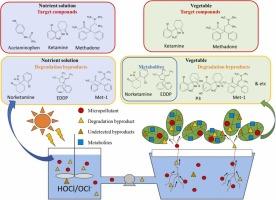用处理过的水栽培的蔬菜中微污染物、副产品和代谢物的积累
IF 12.2
1区 环境科学与生态学
Q1 ENGINEERING, ENVIRONMENTAL
引用次数: 0
摘要
由于水资源匮乏,人们开始使用经过处理的废水灌溉农作物和蔬菜。然而,人们在很大程度上低估了使用经处理的废水栽培蔬菜所带来的微污染物暴露风险。为了澄清这种低估,研究人员对使用添加了三种不同对数 KOW 值药物(对乙酰氨基酚(0.46)、氯胺酮(2.18)和美沙酮(3.93))的营养液栽培生菜的水培系统进行了研究,发现这些药物的总生物浓缩系数(BCFs)(包括代谢物的转化)分别为 0、120±7.76 和 176±16.0 L/kg。为了模拟经过处理的废水,这些营养液在用于生菜栽培之前首先经过了日光光解、氯化和日光/氯处理。在处理过程中,氯胺酮和美沙酮分别转化为诺卡因(最高达 6.0%)和 2-亚乙基-1,5-二甲基-3,3-二苯基吡咯烷(EDDP)(最高达 16%)。此外,莴苣还吸收了其他降解副产物(包括营养液中的 3 种痕量副产物和 13 种未检测到的副产物)。与此同时,氯胺酮和美沙酮也能在莴苣中发生新陈代谢;当氯胺酮浓度从 1000 微克/升降低到 50 微克/升时,转化为诺卡西酮的比率从 22±7.0% 增加到 45±0.062。本文章由计算机程序翻译,如有差异,请以英文原文为准。

Accumulation of Micropollutants, Byproducts, and Metabolites in Vegetables Cultivated with Treated Water
Due to a lack of water resources, people are starting to use treated wastewater to irrigate crops and vegetables. However, the risk of micropollutant exposure from vegetables cultivated with treated wastewater has been largely underestimated. To elucidate this underestimation, a hydroponic system for lettuce cultivation using a nutrient solution spiked with three pharmaceuticals with different log KOW values (acetaminophen (0.46), ketamine (2.18) and methadone (3.93)) was examined, and the total bioconcentration factors (BCFs) (including the transformation of metabolites) of the pharmaceuticals were found to be 0, 120±7.76 and 176±16.0 L/kg, respectively. To simulate treated wastewater, these nutrient solutions were first treated by sunlight photolysis, chlorination, and sunlight/chlorine before use in lettuce cultivation. During the treatment, ketamine and methadone were transformed into norketamine (up to 6.0%) and 2-ethylidene-1,5-dimethyl-3,3-diphenylpyrrolidine (EDDP) (up to 16%), respectively; the BCF of norketamine (162±22.6 L/kg) was found to be even greater than ketamine. In addition, other degradation byproducts (including 3 trace and 13 undetected byproducts in the nutrient solutions) were taken up by the lettuce. In parallel, ketamine and methadone can also undergo metabolism in lettuce; the conversion rate to norketamine increased from 22±7.0% to 45±0.062 when the ketamine concentration decreased from 1000 to 50 μg/L.
求助全文
通过发布文献求助,成功后即可免费获取论文全文。
去求助
来源期刊

Journal of Hazardous Materials
工程技术-工程:环境
CiteScore
25.40
自引率
5.90%
发文量
3059
审稿时长
58 days
期刊介绍:
The Journal of Hazardous Materials serves as a global platform for promoting cutting-edge research in the field of Environmental Science and Engineering. Our publication features a wide range of articles, including full-length research papers, review articles, and perspectives, with the aim of enhancing our understanding of the dangers and risks associated with various materials concerning public health and the environment. It is important to note that the term "environmental contaminants" refers specifically to substances that pose hazardous effects through contamination, while excluding those that do not have such impacts on the environment or human health. Moreover, we emphasize the distinction between wastes and hazardous materials in order to provide further clarity on the scope of the journal. We have a keen interest in exploring specific compounds and microbial agents that have adverse effects on the environment.
 求助内容:
求助内容: 应助结果提醒方式:
应助结果提醒方式:


